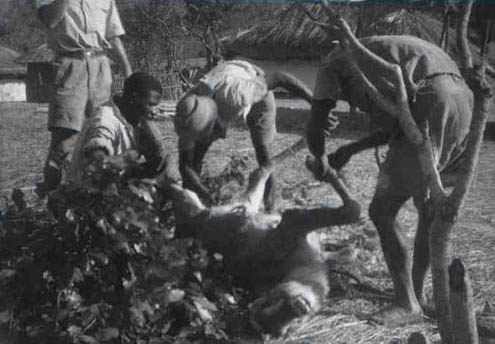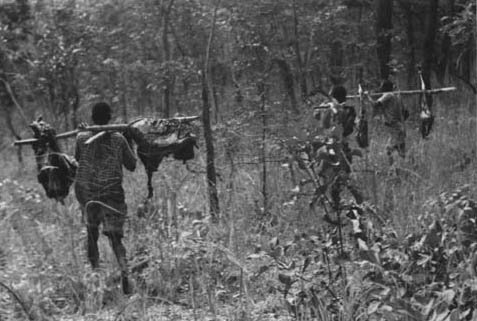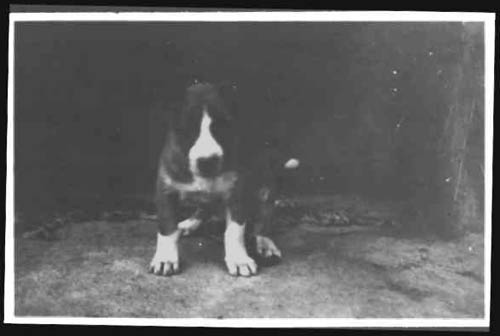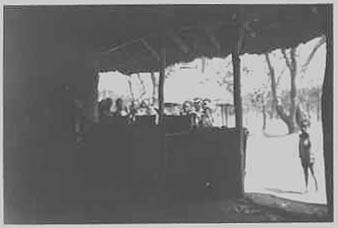Part 2 - Life in the Bush
I last time gave a very sketchy description
of my arrival as a 17yr old in the bush in the far North of NR,
at Kalungu , near the Tanganyika border.
I avoided going into any detail of our
life there but maybe I can expand a little on what was special
about that kind of existence for those who lived on the 'bush
stations' so had a certain degree of organisation around them.
shops, telephones, electricity supplies , running water etc and
yet considered themselves 'in the bush'.
We had none of those things, Food was
what we grew ourselves in the way of vegetables, eggs purchased
at one teaspoon of salt each, chickens at one shilling each, meat
I shot. We had some dehydrated vegetables in tins as a standby,
but they were awful. Dried powdered milk and bottles of 'camp
coffee' were the drink.
We had no refrigerator but found various
ways of preserving food. Our coldbox was a cabinet about 2ft cube
covered with mosquito netting and hessian was draped over it with
the lower edges in a reservoir of water. The water kept the hessian
wet and as it evaporated it cooled and kept the contents cool.
A variation on this was a double walled cabinet with charcoal
in the wall and when this was kept wet it cooled in the same way.
I tried several ways of preserving meat
for the times when no bloody fresh meat was available. We used
the biltong dried meat, hanging strips of meat treated with spices,
salt and pepper which was fine as biltong but could not be re-constituted
as meat for other dishes.

Bush Butchers
I used to take strips of this with me
when I went hunting and felt well nourished with it during a whole
day walking, sometimes covering as much as forty miles. I always
took a canvas 'water bag' which kept the water cool. My African
hunters would go a whole day without any food or water at all.

Bringing Home the Meat
I had 45 gallon drums filled with salt
water into which I put chunks of game meat which did not go rotten
but when soaked in fresh water and used in stews etc refused to
be anything other than tough, stringy, slimy bits of meat.
I sometimes resorted to night shooting
with a 'bulala lamp'. I got quite good at night hunting with my
.22 rifle with the aid of a torch strapped on my forehead, picking
out the reflected eyes of mainly duiker. The trick with night
shooting was to blacken the backsight with soot and shine up the
frontsight. The colour and size of each animals eyes was different
and usually could be relied on except that mistakes could be made.
I once shot at a leopard with the .22 thinking it was a reedbuck
and even more awful was my own dog, Jock (of the bushveldt) that
I mistook for a duiker!!

Jock with the leopard skin behind
him
I managed to keep a supply of fresh
meat for the camp most of the time but my Father kept me pretty
busy with him on the bridge.
While at Kalungu a leopard had attacked
our family dog one night. The dog escaped into the house but the
leopard came back every night. Twice I shot at it from the front
step of the house with the .303 and missed.
On the third occasion I used the .22
which I was more familiar with for night shooting. The following
day a villager brought in a leopard skin from an animal he found
in the bush nearby. It had just one small puncture in the neck
so I took it as my kill. Apart from a strip which I put around
my bush hat the skin hung around with us for years until dogs,
cats, insects etc reduced it to tatters.
I wonder if anyone still has a 'Saucepan
Radio'? I think they were always blue and were made using the
pressings of saucepans. They contained valves and the usual controls
and we could pick up Lusaka radio and ' Radio Club de Mocambique'.
I can't remember if we got 'The General Overseas Service of
the BBC'.
They were powered by a dry battery and
were wonderful. For most Africans they were their first encounters
with radios and when broadcasts were begun in some of the main
African languages a whole new world opened up for them.
Our music was from wind-up gramophone
using fibre needles and when they ran out we substituted acacia
thorns with no noticeable difference. Our evenings in the bush
playing Opera, symphonies and concertos etc on 78rpm records always
attracted listeners to the trees surrounding the camp. Whenever
any one of us stood up into view there was always a rustle of
movement in the trees around us as the spectators moved back out
of sight. I wonder what they thought of Beethoven and Verdi etc.

A gramophone recital audience
in the bush!
Communications were interesting. With
no telephone or radio contact, if we wanted to send messages anywhere
it had to be done from a boma and our nearest was Isoka, 30 miles
away. We used to send a runner, with a cleft stick. I don't know
why we did not send the truck (perhaps it was away collecting
things) but the message always got to the boma from where it was
sent on, by telegraph to headquarters. Our mail was brought once
a week by the Road Superintendent, Henry Walsh on his weekly tour
of the roads.
The construction methods for the bridge
were very primitive as I mentioned before. The scaffolding for
what was quite a large structure was made from bush poles cut
and brought on the heads of a very large number of local villagers,
men and women. The poles were tied together using ulushishi,
bark rope. The bark was stripped from the trees in long lengths
and soaked for a few days in the river to make it soften and pliable
enough to tie knots in it.

Scaffolding
If more flexible rope was needed the
bark was torn into thinner strips and then twisted in the same
way as ropes are made today so that each of three or four strands
was twisted in the opposite direction to its neighbour. This was
done mainly on the thighs of the workers. You might have observed
that Africans have very little body hair. I myself could not roll
rope or string on my thighs without suffering greatly as I 'plucked'
my hairy thighs.
We had one 14/10 diesel concrete mixer
to make all the concrete and no other mechanical aids. Concrete
was 'punned' by hand, no mechanical vibrators as in normal use
everywhere else and the constant stream of women and picannins
carried water for keeping the concrete damp and cool.
The only supplies received from 'line
of rail' at Broken Hill were the cement and reinforcing steel
which Thatcher and Hobson (which later became C.A.R.S.) delivered
in 30 ton loads. Everything else had to be found, created, invented,
adapted from what was available in the bush around us.
We were very sad when the bridge was
finished. It and our life there and the wonderful big bush house
had been our whole life for so long. Everything we had done and
learned had been totally new to us and the lessons learned influenced
nearly everything we did from then on.
We left the charming hardworking pleasant
Benamwanga tribe behind us and entered Wabemba country
but never forgot those interesting people.
Roy Williams

